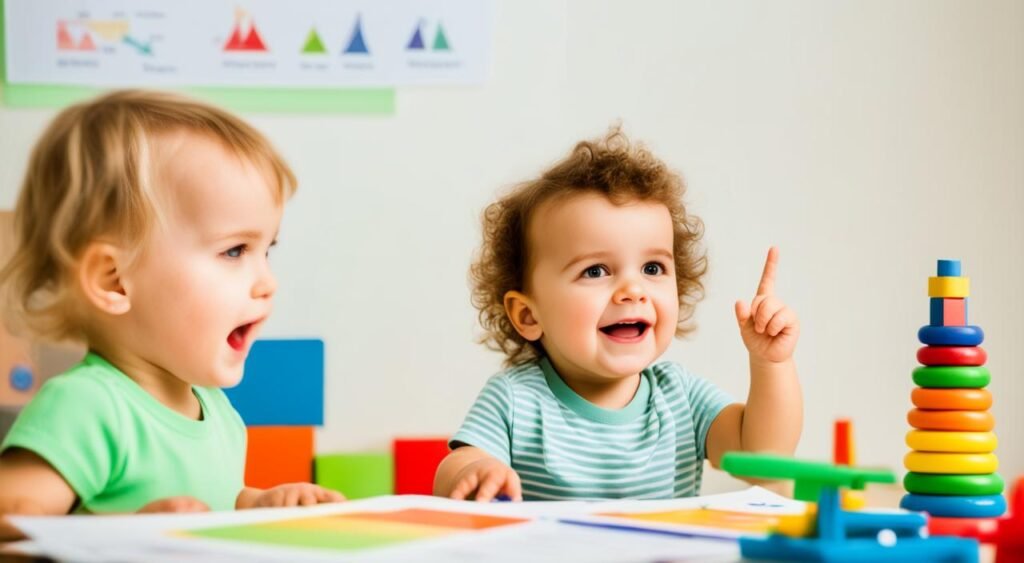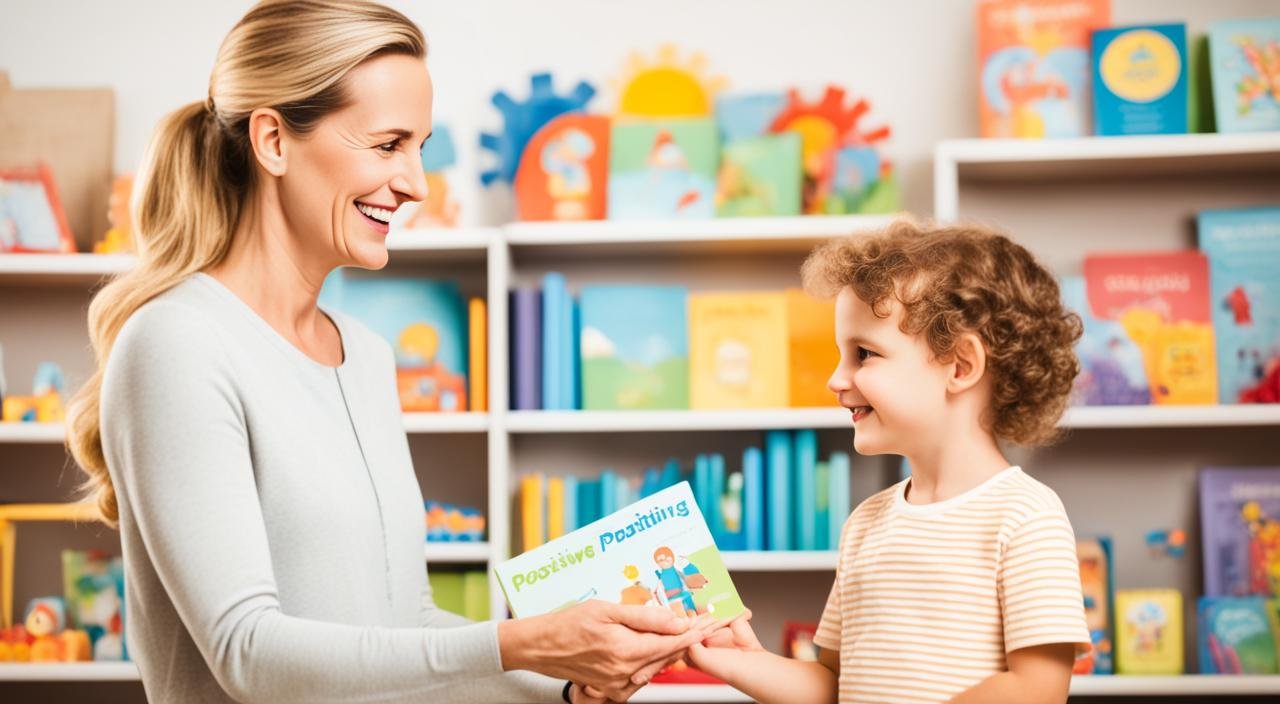Disciplining kids can be tough. But, there are better ways than yelling or hitting. Positive discipline is key. It helps build a strong bond between parents and children, teaching skills like responsibility and self-control.
Studies show yelling and hitting kids can cause serious problems. These include more likely school dropout, depression, drug use, suicide, and heart disease. Positive discipline is all about setting up a healthy parent-child relationship. It includes clear expectations and using smart strategies, like distraction, to handle bad behaviors.
Key Takeaways
- Positive discipline is more effective than yelling or hitting for managing child behavior.
- Building a strong parent-child relationship is key to positive discipline.
- Setting clear expectations and using creative distraction techniques can help avoid harsh discipline.
- Positive reinforcement and teaching emotional intelligence are important aspects of positive discipline.
- Tailoring discipline strategies to the child’s age and developmental stage is crucial.
Understanding the Importance of Positive Discipline
Positive discipline focuses on building a loving relationship with your child. It teaches skills like responsibility and self-control. According to Professor Lucie Cluver of Oxford University, positive discipline is better than yelling or hitting. It helps kids learn and grow, not just control their behavior through fear and pain.
Why Positive Discipline is Effective
The benefits of positive parenting are clear. When parents concentrate on positive actions and teach life skills, kids start doing things on their own. This approach aids them in learning from mistakes and developing a mindset for growth. They move towards goals without just trying to avoid being punished.
The Negative Impact of Yelling and Hitting
Conversely, yelling and hitting kids can have very bad effects. Research shows that harsh discipline and its toxic stress increase chances of dropping out of school, getting depressed, using drugs, committing suicide, and even getting heart disease later on. By choosing positive discipline instead of these harmful methods, parents can set their kids up for success both in the near future and as they grow up.
Building a Strong Parent-Child Relationship
One big part of positive discipline is strengthening the parent-child bond. Experts advise spending one-on-one time with the child, even if it’s just 5 to 20 minutes daily. This should be a time with no TV or phones, just you and them. It makes your child feel special and deepens your relationship.
Dedicating One-on-One Time
It’s important to make time for your child without any distractions. This can greatly benefit in strengthening the parent-child bond. This special time together helps you understand and connect with your child. It builds a feeling of security and trust in them.
Praising Positive Behavior
One more key to positive reinforcement parenting is to praise your child’s good behaviors. Celebrate even the small successes to show you appreciate them. This makes them feel good and important. It also strengthens the bond between you and your child. Plus, it motivates them to keep doing good things.
Setting Clear Expectations and Boundaries
Positive discipline is all about setting clear rules for how kids should behave. Lucie Cluver, a top expert in parenting, tells us that we should show kids what to do, not just what not to do. By telling them the rules and what happens if they break them, kids know what’s expected.
Communicating Rules and Consequences
Rules should be clear and match the child’s age. When explaining rules, stay calm and make sure the child gets it. Also, it’s vital to let them know what bad behavior will lead to. This could be losing a toy, saying sorry, or a time-out. Always stick to these consequences to help kids understand.
Age-Appropriate Expectations
Remember, what’s good for a young child might not work for a teen. Cluver suggests fitting your discipline style to your child’s age and understanding. For young ones, simple rules and immediate consequences work best. As they get older, you can add more rules and let them help set them.
Parents who set clear rules and expectations, explain the consequences, and use good discipline for their child’s age can guide their kids well. This way, there’s no need for yelling or hitting.
How to discipline a child without yelling or hitting?
A child’s misbehavior can be handled without raising your voice or hitting them. Professor Lucie Cluver, a child development expert, suggests creative distraction. This means engaging the child in a positive activity to stop the bad behavior.
Creative Distraction Techniques
Changing the subject, playing a game, or going for a walk can help. The aim is to shift the child’s focus to something fun and beneficial. This avoids making things worse with harsh words or punishments. Using creative distraction helps you stay calm and nurturing with the child.
Calm Consequence Implementation
Another good method is calm consequence implementation. Setting clear rules and consequences is key. Then, when a rule is broken, respond calmly. The consequence should make sense for the child’s age and be given without anger.
These methods help parents manage their child’s behavior without damaging their relationship. It also helps children learn important life skills.
Fostering Emotional Intelligence and Self-Regulation
Positive discipline values teaching kids emotional intelligence and self-regulation. It helps them understand and show their feelings in safe ways. Kids learn self-control and how to solve problems.
Teaching Emotion Identification and Expression
Parents help children name their feelings to manage them better. This involves discussing feelings, reading, and playing out different situations. They should also encourage kids to show their feelings appropriately through art, writing, or talking.
Encouraging Self-Control and Problem-Solving
Positive discipline teaches self-control and problem-solving too. Kids learn breathing exercises, mindfulness, and other tools to manage their emotions. Parents help kids tackle problems by thinking through issues, finding solutions, and acting on them.
This approach helps kids gain emotional intelligence and self-regulation skills. It equips them to deal with their emotions and actions well. Thus, they can face life’s challenges with positive solutions and attitudes.
Age-Specific Discipline Strategies

Discipline should match a child’s age to be effective. Parents can use different age-appropriate discipline techniques for each stage of their child’s life. This helps kids learn right from wrong in a loving way.
Strategies for Infants and Toddlers
For positive discipline for infants and toddlers, parents should lead by example. Use friendly words and change the subject when needed. A calm, steady routine and lots of cuddles are key for good behavior.
Strategies for Preschoolers and School-Age Children
When kids are in preschool and school, set rules together. Teach them to manage feelings and keep praising their good deeds. Positive discipline for these ages focuses on talking openly, learning how to solve problems, and taking on responsibilities.
Strategies for Adolescents and Teenagers
Teen years need a special discipline approach. It’s about setting rules but also being open, letting teens have a say, and building trust. Parents guide teens to think for themselves and work together to deal with any issues.
Conclusion
Positive discipline teaches better ways to guide children than yelling or hitting. It focuses on building trust, setting clear rules, and using creative ways to handle behavior. With this method, kids learn skills like how to be responsible and control their feelings.
It might need more time and work, but it’s worth it. Positive discipline helps kids learn not only from their good choices but from their mistakes, too. Kids grow into adults who can manage their actions well and build a successful life.
Choosing positive discipline means creating a home where a child can thrive. It is a step-by-step process that needs steady effort, but the result is children who are smart emotionally, responsible, and strong. The journey is challenging, but the benefits are priceless.
FAQ
What is positive discipline and why is it more effective than harsh discipline methods?
Positive discipline focuses on strong, positive relationships with children. It teaches skills like responsibility and self-control. This is instead of just punishing children. According to Professor Lucie Cluver from Oxford University, positive discipline works better. It helps kids learn and grow, not just fear punishment. This approach leads to better development and behavior in children.
What are the negative impacts of yelling and hitting children?
Shouting and hitting can hurt children in many ways. It can increase their risk of dropping out of school, feeling depressed, and using drugs. These harsh methods can also make them more likely to think about suicide. Additionally, it can harm their physical health, including their hearts.
How can parents build a strong, nurturing relationship with their child?
To build a strong relationship with your child, spend quality time with them. Cluver suggests taking 5-20 minutes a day to only focus on your child, without any distractions. This could be reading a book, drawing, or playing. It helps your child feel loved and strengthens your bond.
How can parents set clear expectations and boundaries for their child’s behavior?
Clear rules and expectations are crucial in positive discipline. Cluver says that telling children what you want them to do is key. This is better than only telling them what they shouldn’t do. Explaining rules and their consequences helps children understand clearly what is expected of them.
What are some positive discipline techniques parents can use instead of yelling or hitting?
When a child’s behavior is challenging, it’s best to avoid yelling or hitting. Cluver suggests creative distraction as a great method. This means shifting the child’s focus to a more positive activity. You could try changing the topic, a fun game, or a walk. This moves their attention from the misbehavior.
How can parents help their children develop emotional intelligence and self-regulation skills?
Positive discipline is also about boosting kids’ emotional skills and self-control. This means helping them understand and express their feelings. It involves teaching healthy ways to manage emotions. Encouraging problem-solving and self-control helps kids handle their feelings better.
What are some age-specific positive discipline strategies?
Positive discipline varies with children’s ages. For babies and toddlers, showing positivity and using gentle redirection is best. With older kids, having them help set rules and teaching emotion management is effective. Always praise good behavior at any age.





